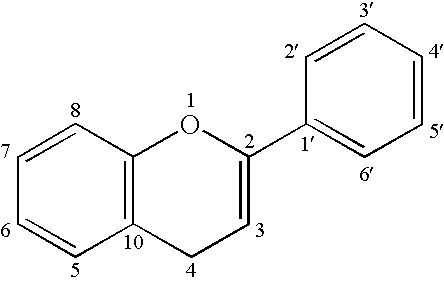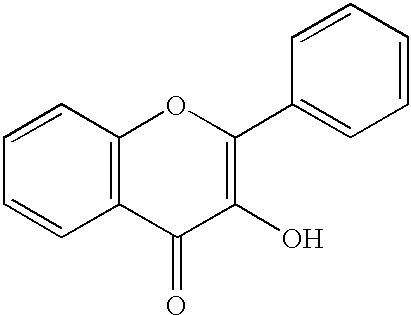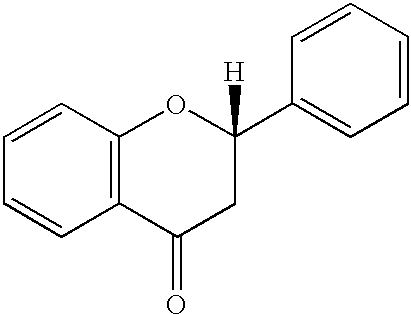Oral compositions and use thereof
a technology of oral compositions and compositions, applied in the field of oral compositions and use thereof, can solve the problems of tooth loss, sparse information on the biological properties of specific compounds, and inability to be useful,
- Summary
- Abstract
- Description
- Claims
- Application Information
AI Technical Summary
Problems solved by technology
Method used
Image
Examples
example 1
Effect of Terpenoids and Flavonoids on GTF Activity in Solution and Adsorbed onto Saliva-coated Hydroxyapatite Surface Assay
[0070] For solution assays, purified GTF B, C, D and Ss were mixed with a two-fold dilution series of the test compounds (concentration ranging from 125 to 500 .mu.M) and incubated with [.sup.14C-glucose]-sucrose substrate (0.2 .mu.Ci / ml) (200.0 mmol / l sucrose, 40 .mu.mol / l dextran 9000, 0.02% sodium azide in adsorption buffer--50 mM KCl, 1.0 mM KPO.sub.4, 1.0 mM CaCl.sub.2, 0.1 mM MgCl.sub.2-pH=6.5) to reach a final concentration of 100 mmol / l sucrose (200 .mu.l final volume). For the control, the same reaction was carried out, where ethanol:DMSO (final concentration of 7.5% and 1.25%, v / v) or ethanol (final concentration of 5%, v / v) replaced the test agent solutions. The samples were incubated 37.degree. C. with rocking for 4 h. After incubation, ice-cold ethanol (1.0 ml) was added and the samples were stored for 18 h, 4.degree. C. for precipitation of glucan...
example 2
Determination of Antibacterial Activity
[0075] The minimum inhibitory concentration (MIC) and minimum bactericidal concentration (MBC) were determined for each test compound according to the National Committee for Clinical Laboratory Standards guidelines (Tentative standard M26-T, 1992; NCCLS Publication No. M7-A5, 2000) and Koo et al. (2000b). The broth microdilution and macrodilution methods (in TSB) were used for the antibacterial tests. The starting inoculum was 5.times.10.sup.5 CFU / ml and the concentrations of test compounds ranged from 15.6 to 500 .mu.M (two-fold dilutions). The MICs and MBCs were determined in quadruplicate in at least 3 different experiments.
[0076] The flavanones, dihydroflavonols, and some terpenoids (tt-farnesol and .beta.-caryophyllene) tested in this study showed moderate inhibitory effects (8-45% for GTFs in solution and 7-24% for GTFs on surface at a concentration of 500 .mu.M); the cinnamic acid derivatives showed negligible effects on GTF enzymes. In ...
example 3
Antibacterial Assays in Biofilms
[0087] To complement the data presented in Examples 1 and 2, biofilms of S. mutans UA159 and S. sobrinus 6715 were used for time-kill studies. Biofilms were formed on standard glass microscope slides in batch cultures for 5 days (Curran et al., 1998). Cells of mutans streptococci were grown in tryptone-yeast extract broth with addition of 1% (w / v) sucrose at 37.degree. C. and 5% CO.sub.2. Typically, 5-day-old biofilms yield approximately 10.sup.9 colony forming units (CFU) per slide. The killing assays were performed according to Phan et al. (2000). Briefly, 5-day-old biofilms were exposed to test agents (1.33 mM, final concentration) in salt solution (50 mM KCl, 1 mM MGCl.sub.2, pH 7.0) containing DMSO:ethanol (10% and 0.625%, v / v) at 25.degree. C. At specific intervals, the biofilms were removed, suspended in 0.89% NaCl solution, and subjected to sonication by a Branson Sonifier 450 (two times, each three 10-second pulses with 5-second intervals at ...
PUM
 Login to View More
Login to View More Abstract
Description
Claims
Application Information
 Login to View More
Login to View More - R&D
- Intellectual Property
- Life Sciences
- Materials
- Tech Scout
- Unparalleled Data Quality
- Higher Quality Content
- 60% Fewer Hallucinations
Browse by: Latest US Patents, China's latest patents, Technical Efficacy Thesaurus, Application Domain, Technology Topic, Popular Technical Reports.
© 2025 PatSnap. All rights reserved.Legal|Privacy policy|Modern Slavery Act Transparency Statement|Sitemap|About US| Contact US: help@patsnap.com



